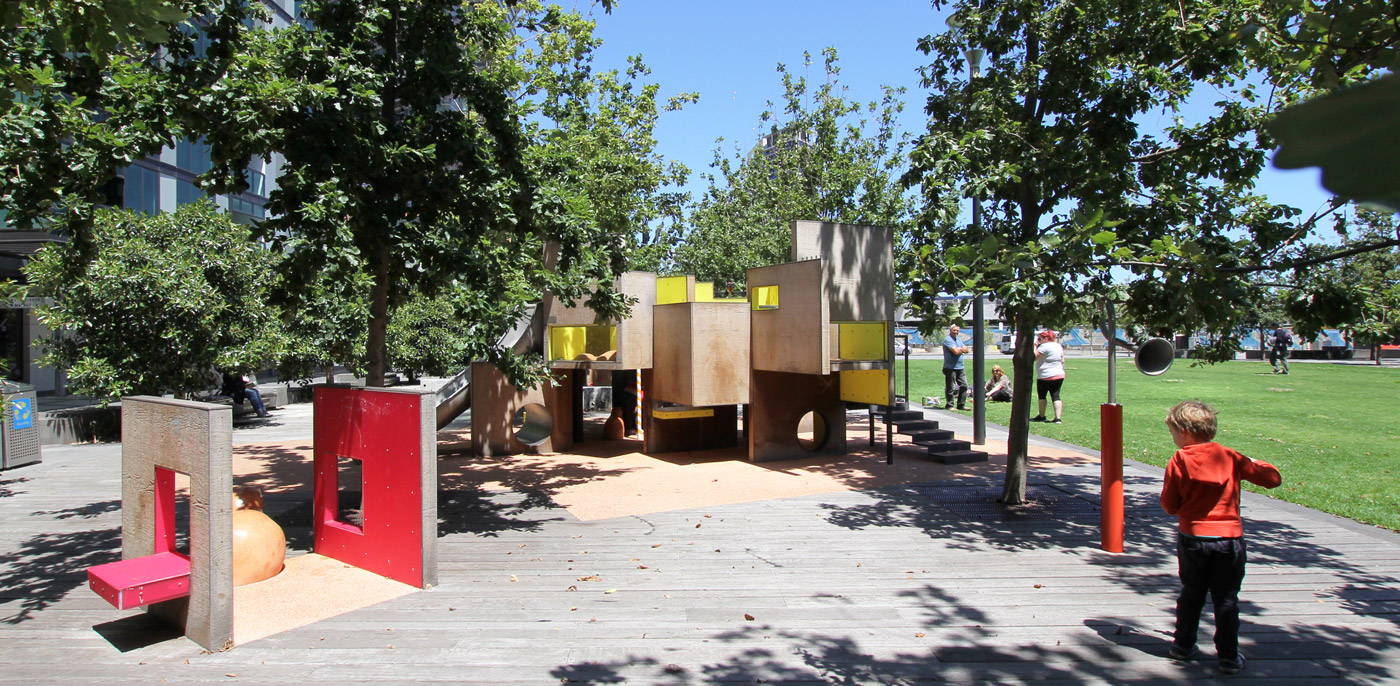Have we really designed our public realm to accommodate a diverse range of use, by a diverse range of user groups? Aspects of our public realm utilising sharing are generally poorly developed due to our reliance on single use thinking. Ownership and management structures also play an integral role in shaping our use of public space. When harnessed as a primary design generator, sharing could assume a much deeper role within the way we consider, design, manage and maintain our public realm. This will unlock a range of unexpected, innovative and engaging new uses. Spaces such as residential verges, suburban streets, school playgrounds, sporting ovals, empty development blocks as well as flood prone land are currently under-utilised and possess potential to more meaningfully contribute to a wider range of users within local communities.
Opportunities within the public realm generated by different times of use require further exploration. Large areas of land within our public realm are subject to flooding at certain times of the year. Flood plains and catchment basins are often inaccessible to the public throughout the entire year, but could easily accommodate active use during dry seasons. Use of this land is dictated by one in hundred, one in fifty or yearly events. Many cities such as Amsterdam have adapted to and designed for flooding. Necessity means use of flood prone land in these cities will always exceed ours however we have many flood effected spaces, especially in inner city areas undertaking significant infill, which could benefit surrounding residents, businesses and community groups at certain times.
Many low traffic suburban streets are commonly used during peak hour when people are traveling to and returning from work but seldom used during the middle of the day. Carefully designed, these present opportunities for shared community use such as green spaces or play spaces. The City of Vincent has been testing this idea on Shakespeare Street in Mount Hawthorn, Rae Street in Leederville as well as at the Hyde Street Reserve in Mount Lawley through its 'Roads to Parks' project. Residential verges also have significant unrealised potential. Current verge planting programs apply shared values to these spaces but they have far greater potential. Weekend use of school playgrounds is often discouraged. Many sporting spaces such as football ovals typically accommodate their intended activity at one or two times during the week but could easily accommodate a broader range of activities by investigating complimentary times of use.
Some privately owned spaces could also contribute to the public realm at certain times in their lifecycle. Vacant inner city sites awaiting development could accommodate a range of temporary uses including community gardens. This way of thinking prioritises experimental short term use rather than focusing on the complex causes of these vacancies. Temporary use can lead to permanent outcomes as it is a low risk inexpensive vehicle to test ideas. It relies on the initiative of local communities. Social rather than economic capital. The Massachusetts Avenue project reclaimed a large proportion of Buffalo's vacant sites for green space during the recession. Buffalo, San Francisco and New York have all now established planning policies to encourage short term public use of vacant sites. This applies a level of flexibility to ownership boundaries which restrict public use of private space during periods of inactivity.
So why isn't this occurring in Western Australia? The role management and maintenance plays in informing the use of public space is underestimated. Community ownership of public space is a key goal of most government policies but is implemented in ineffectual ways through existing land management systems. Large areas of our public realm are managed by one government department dictating its use according to the scope and requirements of that particular department. Co-operation and collaboration between government departments is often lacking restricting opportunities for shared use. Government departments also regularly merge and split, as is currently occurring in Western Australia, causing their priorities to change. Co-ordinated long term investigation of opportunities for shared use are often lost.
Western Australia's metropolitan land is managed or subject to policy generated by a range of government departments1 dependent on its location and primary function. Projects undertaken within the public realm can also involve many other government departments such as Building Management and Works (BMW), LandCorp, Metropolitan Redevelopment Authority (MRA), Public Transport Authority (PTA), Water Corporation and Western Power. Contradicting views and agendas often emerge while working with large groups of government stakeholders. Local community representation within these management structures needs to be significantly strengthened to harness meaningful levels of grass roots local knowledge. Local communities possess drastically different viewpoints on possible use of land.
Use of land is also inherently linked to its maintenance requirements. Golf courses, many of which are currently closing, require high levels of maintenance and resources to accommodate their intended activity. They also have very specific spatial requirements and constant times of use during the day which limit opportunities for shared use. Vandalism is another significant negative force impacting on the use of public space. It demands the use of low maintenance materials and construction which can often limit its appeal and therefore its use. Strategic positioning of public space infrastructure adjacent active community groups, organisations and businesses is an underutilised strategy to generate levels of passive surveillance as well as a sense of implied (shared) ownership.
Parklets are an emerging small scale public realm typology inherently exploring sharing. Parklets reclaim parking bays along town centre streets for use as micro public spaces. They are used by adjacent business owners as alfresco space as well as shared by the public. Beyond their immediate function they embody transferable as well as scalable potential to inform the way we manage, maintain and ultimately use our wider public realm. Parklets transfer the responsibility for maintenance of public space to business owners in exchange for greater control over its use. This establishes a sense of implied ownership functioning as a small scale public private sector partnership.
Our single use mode of thinking as well as our management and ownership structures limit our ability to generate diverse shared use of our public realm. Western Australia's historical surplus of land has played a significant role in the formation of our current approach and management structures. Local knowledge through community group representation needs to be significantly strengthened within government management structures. Emerging small scale public realm typologies such as Parklets embody transferable and scalable potential to inform the way we consider public space. Applying the basic notion of sharing through examining complimentary times of use, flexible private ownership boundaries, strategic location of public realm infrastructure, maintenance responsibility transference, implied ownership and public private sector partnerships could unlock unimagined opportunities for shared use of our public realm in Western Australian.
July 2017
1. The Botanic Gardens and Parks Authority, Conservation and Parks Commission, Department of Planning Lands and Heritage, Department of Land Approvals and Native Title, Department of Parks and Wildlife, Department of Transport and Main Roads Western Australia all manage or generate policy for significant areas of our public realm.
Image - Buluk Park Play Space in Docklands, Melbourne designed by Oculus + Aspect Studios






